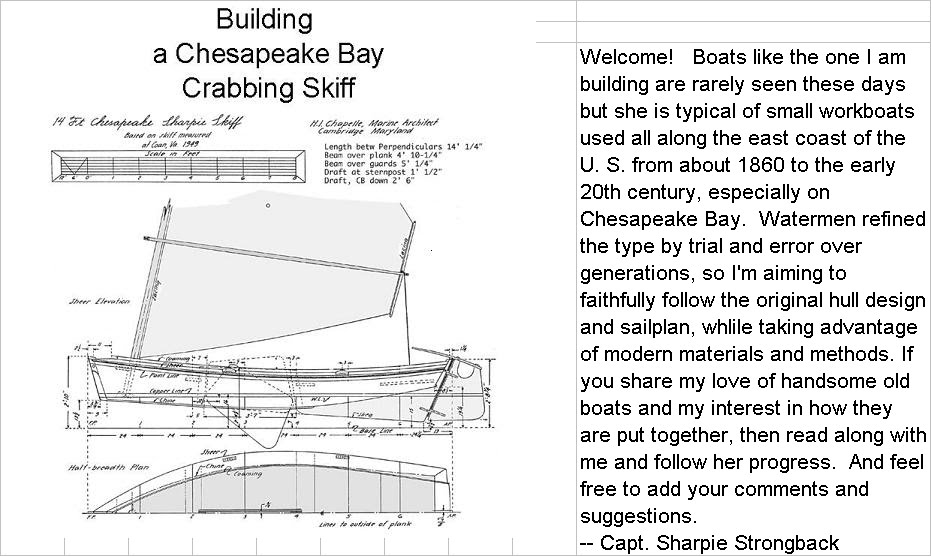Work outside has been limited by rain, but since my last post I have been rebuilding the bow, after seeing that the stem was cut too wide to an unacceptable degree (no pun).
Since I knew I'd have to chop off the sides near the bow, on Sunday I first carefully measured and marked the position of the sides on the molds, to ease the task of returning them to the right place when the repair was done. That was a painstaking and time consuming process, and it was all I got done that day.
I did make a discovery Sunday though which explained why the stem didn't fit originally. When I first set up a guide pattern for the stem, early on, I somehow set it at a rake angle of l6 degrees when it should have been just under 20 degrees. As a result, the sheer end of the stem, which is the lower end since the boat is being built upside down, was unaffected by that mistake; but the upper end of the stem, the chine end, ended up too far forward. As a result, the side panels had to make a sharper bend there to sit alongside the stem. Sure enough, when we had mounted the sides to the stem and bent the assembly around the mold frames, it was the chine end which was strained and distorted. The lower sheer end of the stem was still too wide, but only by a little bit. Evidently, I had measured the stem bevel angle at the sheer end.
Monday I faced up to the inevitable, and cut off the sides alongside the stem with a sawzall, then removed the sides from the molds and made a clean straight cut on each side halfway between mold #1 and where the stem had been. I took the sides inside the house and laid them flat. I rough cut fresh pieces of plywood to replace what had been cut away. The fresh piece for the starboard side was laid under the pattern originally used for the side panels, and the chopped off side panel was laid on top. After the side panel and the pattern were aligned, I traced the missing part onto the fresh piece, and did the same thing for the port side panel.
Today I cut out the replacement bow pieces on the band saw, laid them down with their matching side panels, and made 4 1/2" butt straps and epoxied them over the joints. I secured the pieces together with strapping tape so they wouldn't shift as the epoxy cured.
Also today I salvaged the stem, thus saving a nice piece of white oak. I dug out the bronze screws which had secured the ill-fated side panels before. Since they had been screwed in while the epoxy was still wet, they were impossible to unscrew. I had to chisel the wood away around each one until I could grab the end with vise grip pliers. Even then several of the screws broke off, leaving the tip about 3/4" in. I used the electric plane to clear away the plywood remnants. To avoid hitting embedded screw fragments when I get to cutting down the stem bevel, thereby ruining a plane cutter, I drilled out the screw holes where screws had broken off.
Last time around I secured the sides to the stem and bent the assembly around the molds, following the method recommended in my boatbuilding books, only to discover the stem was wrong. This time, though, I'm going to clamp the sides in place on the molds, brace the stem at the right angle, pull the sides together at the bow, and see how the stem fits, making whatever adjustments and trial fits are needed.
I have learned from this sub-adventure not to epoxy a piece in place until I'm sure it's right, because once two pieces of wood are bonded and the epoxy sets up, even without screws, the bond is stronger than the wood; you can chop the pieces up if you need to, but no force on earth can separate them. That's the good part and the bad part of epoxy.
It remains a mystery how to calculate in advance the angle two sides make at the stem, given the flare of the sides, the rake of the bow, and the angle of the bow at the waterlines. There must be a method, at least for the simple sharpie hull, but I have not found it or figured it out. It's trial and error for me.
I joked a few days ago that the difference between an amateur boatbuilder and a professional is the number of clamps he has. That's funny just because it's obviously not true. But for all my woes, two advantages I do have over a professional are time and accountability. I answer only to myself and I can take however long is needed to do a job to my own satisfaction. That counts for something.
Tuesday, February 2, 2010
Subscribe to:
Post Comments (Atom)

No comments:
Post a Comment